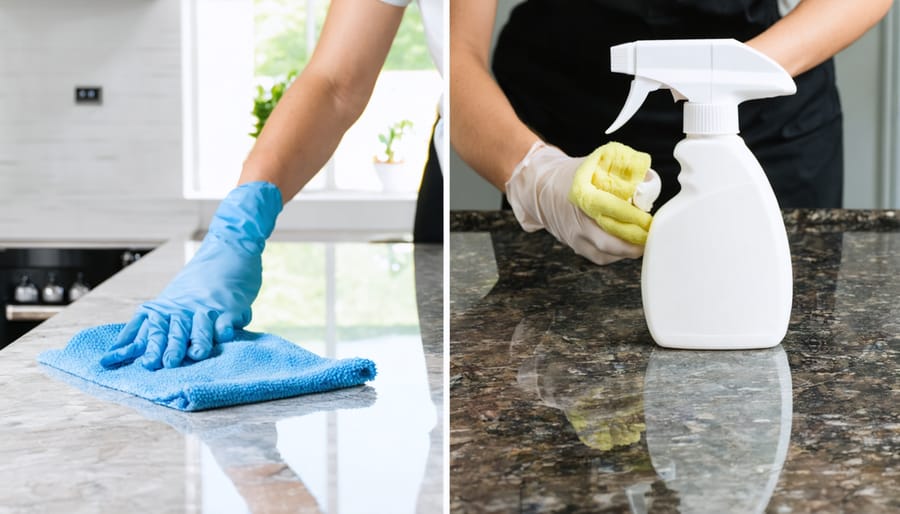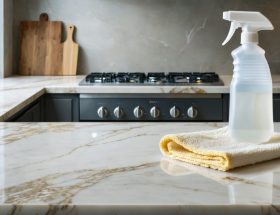Choose between granite and quartz countertops with confidence by understanding their distinct maintenance requirements. While both materials offer exceptional durability comparison between quartz and granite, their care routines differ significantly. Granite demands annual sealing and immediate spill cleanup to prevent staining, whereas quartz resists stains naturally and never needs sealing. This fundamental difference drives long-term maintenance costs and daily cleaning protocols, making it a crucial factor in your countertop decision.
Daily maintenance shapes your experience with either material. Granite requires pH-neutral cleaners and careful attention to acidic spills, while quartz withstands common household cleaners and resists bacterial growth without special treatments. Understanding these maintenance distinctions helps homeowners align their choice with their lifestyle demands and willingness to perform regular upkeep. Whether you prioritize natural stone’s unique patterns or quartz’s predictable low maintenance, this guide will help you make an informed decision based on real-world care requirements.
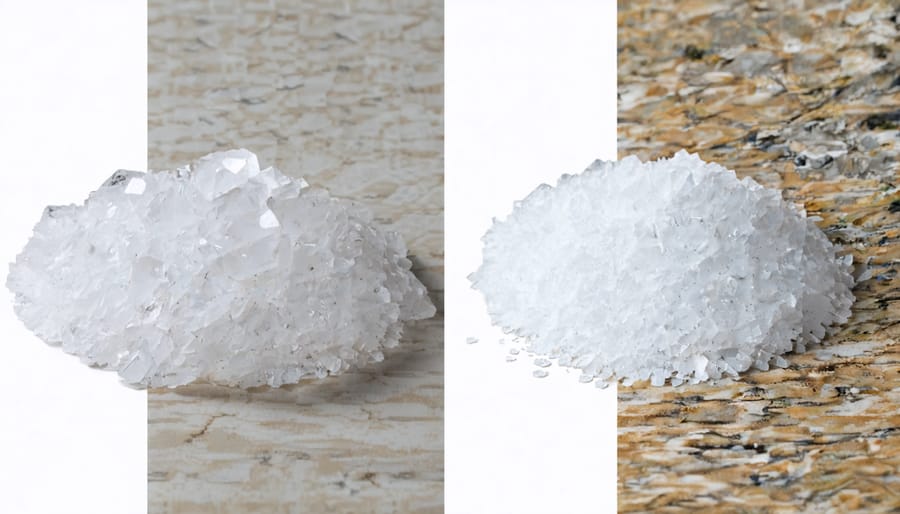
Daily Cleaning Requirements: Quartz vs. Granite
Quartz Daily Care
Daily care for quartz countertops is remarkably straightforward, making it an appealing choice for busy households. For routine cleaning, simply use warm water and a soft microfiber cloth to wipe down the surface. A mild dish soap can be added for tougher spots, but avoid harsh chemicals or abrasive cleaners that might damage the surface.
Unlike granite, quartz doesn’t require special stone cleaners. Common household cleaners containing bleach or vinegar should be avoided as they can dull the surface over time. For best results, clean spills immediately to prevent staining, though quartz’s non-porous nature makes it highly stain-resistant.
To maintain the pristine appearance of your quartz countertop, use cutting boards to prevent scratches and trivets or hot pads under hot items. While quartz is heat-resistant, sudden temperature changes can potentially damage the resin bonds in the material.
Quick cleaning tips:
– Use a damp microfiber cloth for daily wiping
– Clean spills promptly with warm water and mild soap
– Avoid abrasive scrubbers or scouring pads
– Use non-abrasive, pH-neutral cleaners when needed
– Dry the surface thoroughly after cleaning to prevent water spots
Remember that quartz doesn’t need sealing or special treatments, making daily maintenance significantly easier compared to natural stone options.
Granite Daily Care
Maintaining granite countertops requires consistent but straightforward daily care to preserve their natural beauty and durability. The most essential granite cleaning methods involve wiping surfaces with a soft microfiber cloth and warm water after each use. For deeper cleaning, use a pH-neutral stone cleaner specifically formulated for natural stone surfaces.
Never use acidic cleaners, vinegar, lemon juice, or abrasive cleaning products, as these can damage the stone’s surface and compromise its seal. Common household cleaners, including glass cleaners and all-purpose sprays, should also be avoided as they can dull the stone’s finish over time.
For daily spills and messes, immediately blot the area with a clean cloth rather than wiping, which can spread the spill. Food preparation areas should be cleaned with a stone-safe disinfectant to ensure proper sanitization without harming the granite’s surface.
Keep a dedicated cleaning kit near your granite surfaces, including:
– pH-neutral stone cleaner
– Clean microfiber cloths
– Soft sponges
– Stone-safe disinfectant spray
– Plastic scraper for stuck-on debris
Remember to place hot pads under cooking vessels and use coasters under drinks to prevent potential thermal shock or staining, even though granite is naturally heat-resistant.
Sealing and Long-term Protection
Quartz Sealing Facts
Unlike granite, quartz countertops don’t require sealing – ever. This is one of the most significant advantages when considering long-term quartz maintenance. The reason lies in its manufacturing process and composition. Quartz countertops are engineered using approximately 90-95% ground natural quartz mixed with 5-10% polymer resins and pigments. During production, these materials are combined under intense heat and pressure, creating a non-porous surface.
This non-porous nature means liquids cannot penetrate the material, eliminating the need for periodic sealing. The polymer resins act as a permanent sealant, binding the quartz particles together and creating an impermeable barrier against stains, bacteria, and moisture. This inherent seal doesn’t wear down over time, maintaining its protective properties throughout the life of the countertop.
The absence of sealing requirements not only saves time but also reduces long-term maintenance costs. While granite owners must factor in regular sealing expenses and application time, quartz owners can skip this maintenance step entirely. This sealed-for-life quality makes quartz particularly appealing for busy households and commercial applications where minimal maintenance is desired.
However, it’s important to note that while quartz doesn’t need sealing, it still requires regular cleaning to maintain its appearance. Simple daily cleaning with soap and water is typically all that’s needed to keep the surface looking new and performing optimally.
Granite Sealing Schedule
Granite requires periodic sealing to maintain its protective barrier against stains and moisture. While some newer granite varieties come with enhanced sealers that can last up to 10 years, most granite countertops need resealing every 1-3 years, depending on use and stone porosity.
To determine if your granite needs resealing, perform the water test: place a few drops of water on the surface and wait 15 minutes. If the water beads up, your seal is still effective. If the stone darkens or absorbs the water, it’s time to reseal.
Professional granite sealing typically costs between $200-$400 for an average kitchen, though prices vary by region and surface area. DIY sealing is more economical, with quality granite sealers ranging from $25-$50 per bottle, enough for multiple applications on standard-sized countertops.
The sealing process involves:
– Thorough cleaning of the surface
– Application of sealer (usually 2-3 coats)
– Allowing proper drying time between coats
– Final buffing for optimal results
Most homeowners can complete the sealing process in 2-3 hours, though the surface should be left untouched for 24-48 hours to ensure proper curing. While sealing adds an extra maintenance step compared to non-porous materials like quartz, many homeowners find this periodic task manageable and worth the natural beauty granite provides.
To maximize sealer longevity, avoid harsh cleaners, use cutting boards, clean spills promptly, and follow proper daily care guidelines. Regular maintenance between sealing cycles will help preserve your granite’s appearance and protection.
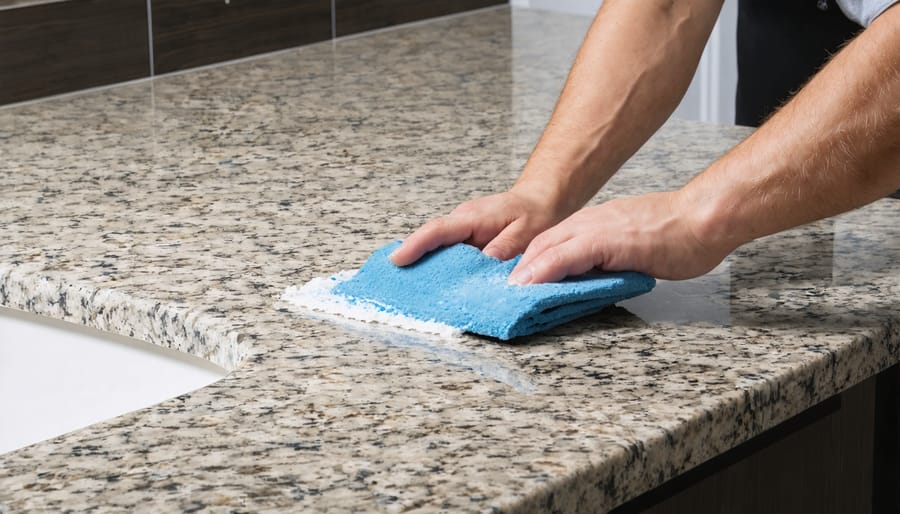
Stain Resistance and Damage Prevention
Quartz Stain Protection
Quartz’s stain resistance is one of its most significant advantages over natural stone countertops. This engineered material combines natural quartz crystals with polymer resins, creating a non-porous surface that naturally repels liquids and staining agents. Unlike granite, which requires regular sealing to prevent stains, quartz’s non-porous nature means liquids cannot penetrate the surface.
Common kitchen culprits like red wine, coffee, olive oil, and tomato sauce simply wipe clean from quartz surfaces without leaving lasting marks. This resistance extends to acidic substances that might etch natural stone surfaces. Even harsh chemicals and strong dyes have minimal impact on quartz’s appearance, making it particularly suitable for busy kitchens and high-traffic areas.
The manufacturing process creates this stain resistance by filling virtually all gaps and pores that might otherwise trap substances. The resin binding agents used in quartz production create an impermeable barrier that extends throughout the entire material, not just the surface. This means that even if the surface sustains minor damage, the stain-resistant properties remain intact.
While no material is completely impervious to staining, quartz comes remarkably close. However, it’s still important to clean spills promptly and avoid leaving harsh substances on the surface for extended periods. Regular cleaning with mild soap and water is typically all that’s needed to maintain quartz’s pristine appearance.
Granite Stain Prevention
While granite’s susceptibility to staining is a common concern, implementing proper preventive measures can significantly reduce this risk. The key to protecting your granite countertops lies in maintaining a robust sealer and practicing good daily habits.
First, ensure your granite is properly sealed upon installation and resealed annually or as needed. To test if resealing is necessary, place a few drops of water on the surface. If the water beads up, your sealer is still effective; if it absorbs within 5-10 minutes, it’s time to reseal.
Implement these daily preventive measures:
– Use coasters under all beverages, especially acidic drinks like wine and citrus juices
– Place hot pots and pans on trivets or heat-resistant pads
– Clean spills immediately, especially oils, wines, and acidic substances
– Use cutting boards instead of cutting directly on the surface
– Avoid placing toiletries directly on bathroom granite surfaces
– Keep cleaning products, cosmetics, and other potentially staining substances in designated containers
For regular cleaning, use pH-neutral cleaners specifically designed for natural stone. Avoid acidic cleaners, bleach, or abrasive products that can compromise the sealer’s effectiveness. By following these preventive measures consistently, your granite countertops can maintain their beauty and resistance to staining for years to come.
Annual Maintenance Costs
When comparing annual maintenance costs between granite and quartz countertops, several factors contribute to the overall expenses. For granite countertops, the yearly maintenance budget typically ranges from $200 to $400. This includes professional resealing every 1-2 years ($150-$300), specialized granite cleaners ($30-$50 annually), and protective treatments ($20-$50 per application).
Quartz countertops generally have lower annual maintenance costs, averaging $100 to $200 per year. Since quartz doesn’t require sealing, the primary expenses are limited to daily cleaning products specifically formulated for engineered stone ($30-$60 annually) and occasional deep cleaning treatments ($70-$140 per professional service, if desired).
Breaking down the routine maintenance costs:
Granite:
– Professional sealing: $150-$300 (annual or biennial)
– Daily cleaning products: $30-$50
– Stain removal products: $20-$40
– Occasional professional cleaning: $100-$200
Quartz:
– Daily cleaning products: $30-$60
– Deep cleaning treatments: $70-$140 (optional)
– No sealing required: $0
– Stain removal products: $20-$40 (rarely needed)
It’s important to note that these costs can vary significantly based on your location, the size of your countertops, and the specific products or services you choose. DIY maintenance can reduce these costs considerably, especially for granite owners who learn to apply sealants themselves. However, professional services often provide better results and may be required to maintain warranty coverage.
Additional factors that might affect maintenance costs include repairs for chips or scratches (more common with granite) and specialized treatments for stubborn stains. While the initial investment in quartz is typically higher, the reduced maintenance costs over time can make it more economical in the long run.
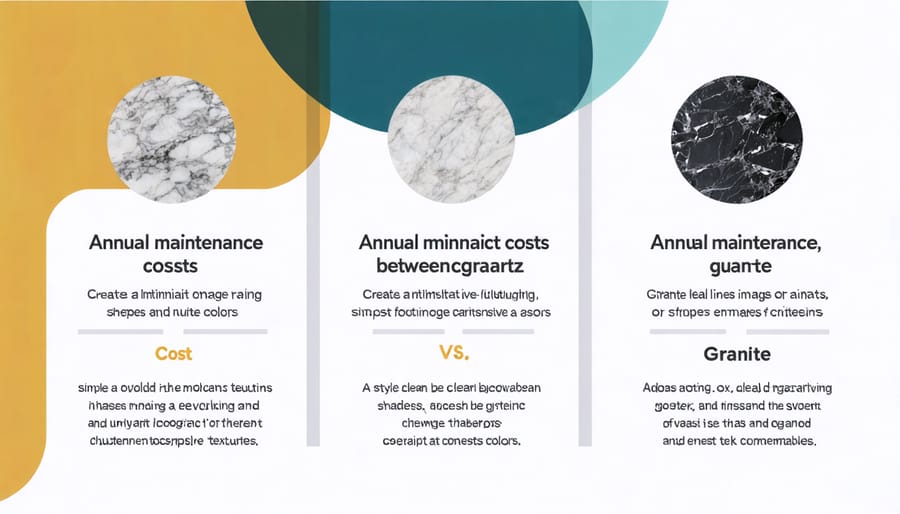
When comparing granite and quartz maintenance requirements, both materials offer distinct advantages and considerations. Quartz emerges as the more low-maintenance option, requiring minimal daily care and no sealing. Its non-porous nature provides superior stain resistance and makes it exceptionally hygienic for busy households. Regular cleaning with mild soap and water is typically sufficient to maintain its appearance.
Granite, while requiring more attention, rewards proper care with timeless beauty and unique natural patterns. The primary maintenance difference lies in the periodic sealing requirement – typically every 12-18 months – and the need for more careful attention to spills and cleaning products. However, many homeowners find this additional care worthwhile for granite’s distinctive appearance and durability.
For those prioritizing minimal maintenance, quartz is the clear winner. It’s an ideal choice for busy families, rental properties, or commercial applications where consistent appearance and easy care are essential. Granite remains an excellent option for homeowners who appreciate natural stone’s character and don’t mind the additional maintenance steps.
The final choice should align with your lifestyle, maintenance preferences, and aesthetic goals. Both materials can provide decades of service when properly maintained, making either option a sound investment for your space. Consider your daily routine, cleaning habits, and long-term maintenance commitment when making your decision.

